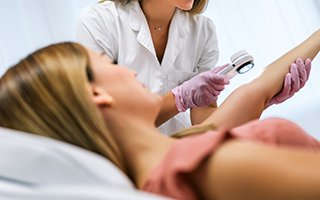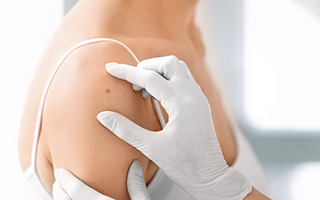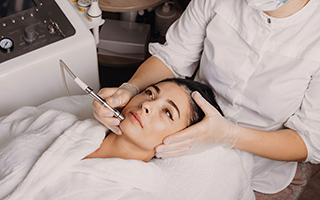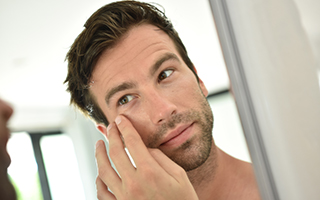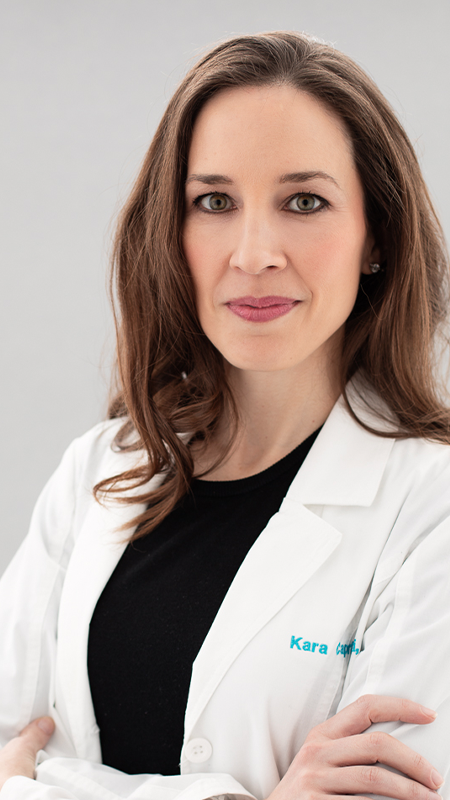Skin Cancer
Learn About the Latest Treatments Available for Carcinomas and Melanoma in Bryn Mawr, Newtown Square, Philadelphia, and the Main Line
- Home
- Medical Dermatology
- SKIN CANCER
Skin cancer is the most common form of cancer, affecting more people in the United States than all other cancers combined. According to the Skin Cancer Foundation, one in five Americans will develop skin cancer during their lifetime. The good news is that while skin cancer is exceedingly common, it is curable with early detection and treatment. Early detection at Bryn Mawr Skin & Cancer Institute can greatly increase the effectiveness of treating skin cancer for Bryn Mawr, Newtown Square, Main Line, and Philadelphia residents. We are conveniently located along the Delaware and Montgomery County border, and close to Chester County residents and businesses.
Learn more about the treatment options for skin cancer at Bryn Mawr Skin & Cancer Institute. To schedule your routine skin check appointment, Please BOOK ONLINE, call 610.525.5028, or Contact Us.
What is Skin Cancer?
Skin cancer is a cancer that starts in the epidermis, the outer layer of your skin. The epidermis contains three main types of cells: squamous cells, basal cells, and melanocytes. The location and cell type in which your cancer begins determines both its type and your treatment options.

What Causes It?
Skin cancer develops when the DNA of skin cells mutate, causing these cells to multiply rapidly and form a tumor.
Ultraviolet (UV) radiation in sunlight as well as the ultraviolet emitting bulbs used in tanning beds are responsible for much of this DNA damage. Other factors may include exposure to toxic substances or having a medical condition that weakens your immune system.
Common risk factors for skin cancer include:
- Fair skin
- A history of sunburns
- Excessive sun exposure
- Sunny or high-altitude climates
- Numerous moles
- Precancerous skin lesions
- A family history of skin cancer
- A personal history of skin cancer
- A weakened immune system
- Exposure to radiation
- Exposure to toxic substances
What Does Skin Cancer Look Like?
There are three major types of skin cancer:
Of these, basal and squamous cell cancers are the most common.
Basal Cell Carcinoma
Basal cell carcinoma is primarily found on parts of the body exposed to the sun, such as the head and neck. The development of basal cell carcinoma is strongly linked to UV exposure. While rarely fatal, basal cell carcinoma can be highly disfiguring if allowed to grow.
Basal cell carcinoma rarely metastasizes to other areas of the body. However, if left untreated, metastasis is possible.
Basal cell cancer typically appears as:
- A pearly or waxy bump
- A flat, flesh-colored “scar-like” lesion
Squamous Cell Carcinoma
Like basal cell carcinoma, squamous cell carcinoma typically occurs on sun-exposed areas of your body, such as your face, ears, neck, and hands. Caught early, it is almost always curable with surgery.
Squamous cell carcinoma can metastasize to other areas of the body if left untreated. Patients with compromised immune systems are more likely to develop squamous cell carcinomas.
Squamous cell carcinoma may appear as:
- A firm, red nodule
- A flat lesion with a scaly, crusted surface
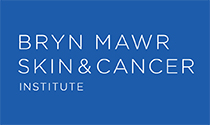
Meet Our Dermatologists &
Certified Physician Assistants
Our board-certified dermatologists & PA-Cs are dedicated to detecting and treating skin cancers. We treat the full spectrum of skin diseases. Our Mohs and Plastic Surgery practices are integrated, and offer patients the most advanced skin cancer treatment, delivering superior outcomes.
Melanoma
Accounting for less than two percent of all skin cancer cases, melanoma is the third most common form of skin cancer, and the most serious. The clear majority of skin cancer fatalities arise from melanoma – the Skin Cancer Foundation estimates that on average, one person dies of melanoma every hour.
Melanoma can occur anywhere on the body. People with darker skin types tend to develop melanoma on the palms or soles, or under the fingernails or toenails.
Like basal cell and squamous cell cancers, melanoma is almost always curable with early detection and treatment. Left undetected and untreated, melanoma is much more likely to metastasize to other partsof the body, where it can be very difficult to treat.
Melanoma may appear as:
- A large brownish spot with darker speckles.
- A mole that changes in color, size, or feel or that bleeds.
- A small lesion with an irregular border and portions that appear red, white, blue, or blue-black.
- Dark lesions on your palms, soles, fingertips, or toes, or on mucous membranes lining your mouth, nose, vagina, or anus.
How is Skin Cancer Diagnosed?
The first line of defense is self-skin examination. Remember the “A, B, C, D, E” signs when performing self-skin examinations of moles or other lesions on your skin:
- Asymmetry of the lesion.
- Border irregularity of the lesion.
- Color variation of the lesion.
- Diameter typically larger than a pencil head eraser (6 mm).
- Evolving change in an existing lesion.
Annual checkups by a dermatologist and checkups to further examine changes noticed during self- skin exams are pivotal to early detection and treatment of skin cancer.
To check for skin cancer, your dermatologist will perform a thorough examination of your skin for changes that are likely to be cancerous or pre-cancerous. A detailed personal and family history of skin cancer will be obtained and reviewed. Regular skin exams are your best option for detecting and treating skin cancer at its earliest stages.
Body Check Appointments at Bryn Mawr Skin & Cancer Institute
Body checks performed by our board-certified dermatologists account for nearly half of all the medical dermatology appointments at Bryn Mawr Skin & Cancer Institute. During a body check appointment, the dermatologist thoroughly examines your largest organ: the skin. Your doctor carefully inspects your skin from the tips of your toes to the top of your scalp and asks if you notice any areas of concern.
If the dermatologist spots a suspicious lesion, a biopsy (sample) will be collected and sent to the pathology lab for closer inspection under a microscope. Adult patients should schedule an annual body check appointment, unless directed to come in more frequently.
To schedule an appointment for a body check, Please BOOK ONLINE, call 610.525.0500 or Contact Us.
If suspicious lesions are found on examination, a biopsy will be taken for pathology testing. Once your dermatologist reviews the pathology report and provides a diagnosis, the best treatment options will be discussed with you.
What Are the Treatment Options?
Bryn Mawr Skin & Cancer Institute offers the Bryn Mawr, Newtown Square, and Philadelphia areas the safest and most advanced skin cancer treatments currently available. These include:
- Mohs surgery
- Excisional surgery
- Curettage
- Cryosurgery
- Prescription topical medications

Meet Our Mohs Surgeons
Kara D. Capriotti, M.D. and John K. Mulholland, M.D. perform Mohs Micrographic Surgery for the treatment of skin cancers. Mohs is a specialized surgery technique that maximizes skin cancer cure rates while minimizing removal of healthy tissue surrounding the cancer. Superior outcomes are achieved with this “tissue-sparing” technique.
If you think you have skin cancer, visit your dermatologist. Early intervention is the key to successful treatment.
Learn more about your skin cancer treatment options near Bryn Mawr, Newtown Square, and Philadelphia. To schedule an appointment with our skin cancer physicians at Bryn Mawr Skin & Cancer Institute, Please BOOK ONLINE, call 610.525.5028, or Contact Us.




